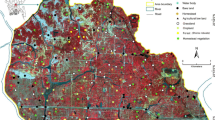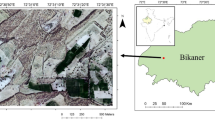Abstract
Land cover classification (LCC) in arid regions is of great significance to the assessment, prediction, and management of land desertification. Some studies have shown that the red-edge band of RapidEye images was effective for vegetation identification and could improve LCC accuracy. However, there has been no investigation of the effects of RapidEye images’ red-edge band and vegetation indices on LCC in arid regions where there are spectrally similar land covers mixed with very high or low vegetation coverage information and bare land. This study focused on a typical inland arid desert region located in Dunhuang Basin of northwestern China. First, five feature sets including or excluding the red-edge band and vegetation indices were constructed. Then, a land cover classification system involving plant communities was developed. Finally, random forest algorithm-based models with different feature sets were utilized for LCC. The conclusions drawn were as follows: 1) the red-edge band showed slight contribution to LCC accuracy; 2) vegetation indices had a significant positive effect on LCC; 3) simultaneous addition of the red-edge band and vegetation indices achieved a significant overall accuracy improvement (3.46% from 86.67%). In general, vegetation indices had larger effect than the red-edge band, and simultaneous addition of them significantly increased the accuracy of LCC in arid regions.
Similar content being viewed by others
References
Adelabu S, Mutanga O, Adam E, 2014. Evaluating the impact of red-edge band from Rapideye image for classifying insect defoliation levels. ISPRS Journal of Photogrammetry and Remote Sensing, 95: 34–41. doi: 10.1016/j.isprsjprs.2014.05.013
Alrababah M A, Alhamad M N, 2006. Land use/cover classification of arid and semi-arid Mediterranean landscapes using Landsat ETM. International Journal of Remote Sensing, 27(13): 2703–2718. doi: 10.1080/01431160500522700
Asner G P, Heidebrecht K B, 2003. Imaging spectroscopy for desertification studies: comparing AVIRIS and EO-1 Hyperion in Argentina drylands. IEEE Transactions on Geoscience and Remote Sensing, 41(6): 1283–1296. doi: 10.1109/TGRS.2003.812903
Batterbury S, Warren A, 2001. The African Sahel 25 years after the great drought: assessing progress and moving towards new agendas and approaches. Global Environmental Change, 11(1): 1–8. doi: 10.1016/S0959-3780(00)00040-6
Belgiu M, Drăguţ M, 2016. Random forest in remote sensing: a review of applications and future directions. ISPRS Journal of Photogrammetry and Remote Sensing, 114: 24–31. doi: 10.1016/j.isprsjprs.2016.01.011
Breiman L, 2001. Random forests. Machine Learning, 45(1): 5–32. doi: 10.1023/A:1010933404324
Cerna L, Chytry M, 2005. Supervised classification of plant communities with artificial neural networks. Journal of Vegetation Science, 16(4): 407–414. doi: 10.1111/j.1654-1103. 2005.tb02380.x
Chen W, Wang Y, Li X et al., 2016. Land use/land cover change and driving effects of water environment system in Dunhuang Basin, northwestern China. Environmental Earth Science, 75: 1027. doi: 10.1007/s12665-016-5809-9
Chen Weitao, Sun Ziyong, Li Xianju et al., 2014a. Natural plant communities mapping in inland arid regions: a case in Dunhuang Basin, northwestern China. Arid Land Geography, 37(6): 1257–1263. (in Chinese)
Chen Weitao, Wang Yanxin, Sun Ziyong et al., 2014b. Groundwater-dependent ecosystems in arid inland zones: A case study at the Dunhuang Basin, northwestern China. Quaternary Sciences, 34(5): 950–958. (in Chinese)
Daskalaki S, Kopanas I, Avouris N, 2006. Evaluation of classifiers for an uneven class distribution problem. Applied Artificial Intelligence, 20(5): 381–417. doi: 10.1080/08839510500313653
Galletti C S, Myint S W, 2014. Land-use mapping in a mixed urban-agricultural arid landscape using object-based image analysis: a case study from Maricopa, Arizona. Remote Sensing, 6(7): 6089–6110. doi: 10.3390/rs6076089
Ge X, Ni J, Li Z et al., 2013. Quantifying the synergistic effect of the precipitation and land use on sandy desertification at county level: a case study in Naiman Banner, northern China. Journal of Environmental Management, 123: 34–41. doi: 10.1016/j.jenvman.2013.02.033
Han L, Zhang Z, Zhang Q et al., 2015. Desertification assessments in the Hexi corridor of northern China’s Gansu Province by remote sensing. Natural Hazards, 75(3): 2715–2731. doi: 10.1007/s11069-014-1457-0
Hatton T, Evans R, 1998. Dependence of Ecosystems on Groundwater and its Significance to Australia. In: Land and Water Resources Research and Development Corporation. CSIRO, Clayton, Australia.
Kim H O, Yeom J M, 2014. Effect of red-edge and texture features for object-based paddy rice crop classification using RapidEye multi-spectral satellite image data. International Journal of Remote Sensing, 35(19): 7046–7068. doi: 10.1080/01431161.2014.965285
Langley S K, Cheshire H M, Humes K S, 2001. A comparison of single date and multitemporal satellite image classifications in a semi-arid grassland. Journal of Arid Environments, 49(2): 401–411. doi: 10.1006/jare.2000.0771
Li X, Chen W, Cheng X et al., 2016. A comparison of machine learning algorithms for mapping of complex surface-mined and agricultural landscapes using ZiYuan-3 stereo satellite imagery. Remote Sensing, 8(6): 514. doi: 10.3390/rs8060514
Li X, Chen W, Cheng X et al., 2017. Comparison and integration of feature reduction methods for land cover classification with RapidEye imagery. Multimedia Tools and Applications. doi: 10.1007/s11042-016-4311-4
Li X, Shao G, 2014. Object-based land-cover mapping with high resolution aerial photography at a county scale in Midwestern USA. Remote Sensing, 6(11): 11372–11390. doi: 10.3390/rs61111372
Liaw A, Wiener M, 2002. Classification and regression by randomforest. R News, 2(3): 18–22
Liu C, Frazier P, Kumar K, 2007. Comparative assessment of the measures of thematic classification accuracy. Remote Sensing of Environment, 107(4): 606–616. doi: 10.1016/j.rse.2006.10.010
Liu S, Wang T, Kang W et al., 2015. Several challenges in monitoring and assessing desertification. Environmental Earth Sci ences, 73(11): 7561–7570. doi: 10.1007/s12665-014-3926-x
Manandhar R, Odeh I O A, Ancev T, 2009. Improving the accuracy of land use and land cover classification of Landsat data using post-classification enhancement. Remote Sensing, 1(3): 330–344. doi: 10.3390/rs1030330
Meyer D, Dimitriadou E, Hornik K et al., 2015. e1071: Misc Functions of the Department of Statistics, Probability Theory Group (Formerly: E1071), TU Wien. Available at: https://cran.r-project.org/web/packages/e1071/index.html
Namdar M, Adamowski J, Saadat H et al., 2014. Land-use and land-cover classification in semi-arid regions using independent component analysis (ICA) and expert classification. International Journal of Remote Sensing, 35(24): 8057–8073. doi: 10.1080/01431161.2014.978035
Nordberg M L, Evertson J, 2003. Vegetation index differencing and linear regression for change detection in a Swedish mountain range using Landsat TM and ETM+ imagery. Land Degradation & Development, 16(2): 139–149. doi: 10.1002/ldr.660
Petropoulos G P, Kalaitzidis C, Vadrevu K P, 2012. Support vector machines and object-based classification for obtaining land-use/cover cartography from Hyperion hyperspectral imagery. Computers & Geosciences, 41: 99–107. doi: 10.1016/j.cageo.2011.08.019
Qin Xuwen, Chen Weitao, Li Xianju et al., 2014. Effects of water environmental system on desertification in an inland region of northwestern China: a case study in Dunhuang Basin. Safety and Environmental Engineering, 21(5), 39–45. (in Chinese)
R Development Core Team, 2015. R: A language and environment for statistical computing and graphics. Available at: https://cran.r-project.org/src/base/R-3/
Rozenstein O, Karnieli A, 2011. Comparison of methods for land-use classification incorporating remote sensing and GIS inputs. Applied Geography, 31(2): 533–544. doi: 10.1016/j.apgeog.2010.11.006
Schuster C, Förster M, Kleinschmit B, 2012. Testing the red edge channel for improving land-use classifications based on high-resolution multi-spectral satellite data. International Journal of Remote Sensing, 33(17): 5583–5599. doi: 10.1080/01431161.2012.666812
Stefanov W L, Ramsey M S, Christensen P R, 2001. Monitoring urban land cover change: an expert system approach to land cover classification of semiarid to arid urban centers. Remote Sensing of Environment, 77(2): 173–185. doi: 10.1016/S0034-4257(01)00204-8
Tigges J, Lakes T, Hostert P, 2013. Urban vegetation classification: benefits of multitemporal RapidEye satellite data. Remote Sensing of Environment, 136: 66–75. doi: 10.1016/j.rse.2013.05.001
Wang X, Chen F, Dong Z, 2006. The relative role of climatic and human factors in desertification in semiarid China. Global Environmental Change, 16(1): 48–57. doi: 10.1016/j.gloenvcha. 2005.06.006
Wu Xiuqin, Liu Hongmeng, Huang Xiulan et al., 2011. Human driving forces: analysis of rocky desertification in karst region in Guanling County, Guizhou Province. Chinese Geographical Science, 21(5): 600–608. doi: 10.1007/s11769-011-0496-7
Xie Y, Sha Z, Yu M, 2008. Remote sensing imagery in vegetation mapping: a review. Journal of Plant Ecology, 1(1): 9–23. doi: 10.1093/jpe/rtm005
Zhang Panpan, Hu Yuanman, Xiao Duning et al., 2010. Rocky desertification risk zone delineation in karst plateau area: a case study in Puding County, Guizhou Province. Chinese Geographical Science, 20(1): 84–90. doi: 10.1007/s11769-010-0084-2
Acknowledgements
We thank Kong Lingfeng, Zhao Duohui, Liu Bo, and Yan Zezhou for helping to conduct the field investigation.
Author information
Authors and Affiliations
Corresponding author
Additional information
Foundation item: Under the auspices of Fundamental Research Funds for Central Universities, China University of Geosciences (Wuhan) (No. CUGL150417), National Natural Science Foundation of China (No. 41274036, 41301026)
Rights and permissions
About this article
Cite this article
Li, X., Chen, G., Liu, J. et al. Effects of RapidEye imagery’s red-edge band and vegetation indices on land cover classification in an arid region. Chin. Geogr. Sci. 27, 827–835 (2017). https://doi.org/10.1007/s11769-017-0894-6
Received:
Accepted:
Published:
Issue Date:
DOI: https://doi.org/10.1007/s11769-017-0894-6




